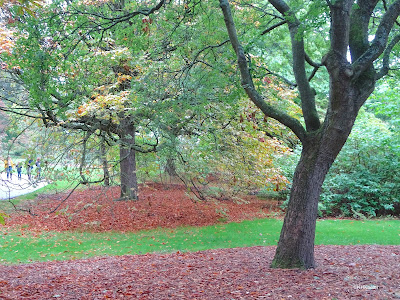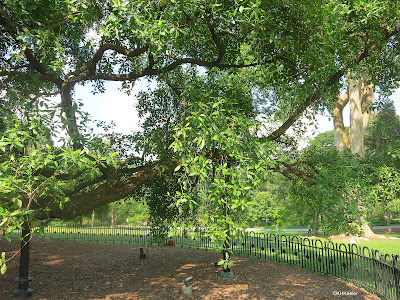Sunday, April 21, 2024
Travel Story - Landscapes of a Cruise Down the Columbia River
Monday, April 15, 2024
Growing Natives in Colorado
There is a national push for homeowners in the U.S. to grow plants native to their area (see previous posts part1; part 2; part 3; HNPwebsite). The number of birds and insects have been dropping over the last 50 years. Lack of food is blamed because we replaced native habitat with lawns and parking lots. Rewilding our neighborhoods is not a realistic solution; what is suggested is that we each grow regional natives on our properties, making our yards contribute to local habitat.
 |
| Alpine clover Trifolium dasyphyllum, an alpine tundranative that won't survive in Denver, though the distance is only 50-60 miles. |
Sunday, April 7, 2024
Strawberries, Fragaria, Beloved Fruits. 2. Uses and Folklore
Strawberries are popular fruits, eaten world-wide. This is despite the fact that fresh strawberries do not improve after harvest and cannot be stored for very long. So popular are they that we have bred them to produce fruit throughout the growing season, not just briefly in June or July, and ship them from warmer climates or big greenhouses for year-round fresh strawberries, and we freeze them or preserve them as jams and jellies to them always available.
 |
| fruit salad with strawberries |
Monday, April 1, 2024
Plant Story -- Strawberries. Fragaria, Beloved Fruits 1. Distribution and Botany
Strawberries, genus Fragaria in the rose family, Rosaceae, are a popular fruit and have been for millennia. Twenty to 24 species are recognized, with cultivated strawberries adding many hybrids and varieties. They are native around the world, mainly in the northern part of the Northern Hemisphere, plus a few Southern Hemisphere species.
 |
| strawberries, Fragaria |
Sunday, March 24, 2024
Polyploidy Part 3. Patterns in Nature: Speciation
Polyploidy is whole genome duplication, when all the chromosomes and so, all the genes, of an organism double. In plants, it is very common; easily 3/4 of plants are polyploid.
 |
| an Oenothera |
Because polyploidy is a genetic effect that takes place inside the cell's nucleus, it is not casually observed. But botanists discovered polyploidy as soon as they had microscopes to look at the contents of the nucleus and when they tried crossing polyploids and got results that didn't make sense based on diploid genetics. (Diploid = 2 copies of the genome, polyploidy = numbers over 2, like 3, 4, and 6 see previous posts in this series link link). Study of polyploidy began in the early 1900s.
Sunday, March 17, 2024
Plant Story--Catnip, Nepeta cataria, a Well-Known Weedy Herb
Catnip, Nepeta cataria, is one of the better-known little herbs because it is a drug for cats. Cats respond to catnip for about 15 minutes, with distinctive behaviors from rubbing on their faces and rolling in it to grooming and salivating. Young kittens do not respond and some adult cats never do. On the other hand, the response is widespread among cats of all kinds, lions, tigers, cheetahs, lynx, pumas and so on, but not dogs or rabbits or rats or other groups of animals. Since cats are common pets, people provide or grow catnip for them, with the result that catnip is known to many people.
 |
| catnip, Nepeta cataria |
Sunday, March 10, 2024
April in Tokyo
Sunday, March 3, 2024
Polyploidy Part 2. And Crop Plants
Polyploidy is whole genome duplication, where all the chromosomes double. Animals rarely survive major chromosome changes, but plants usually do, leading to aspects of plant genetics that are quite different from animals.
 |
| strawberry, Fragaria ananassa |
Even though you cannot easily spot a polyploid by looking at it, polyploidy is not obscure. Many common, important plants are polyploid, for example bread wheat (Triticum aestivum), white potatoes (Solanum tuberosum), coffee (Coffea arabica), sweet potatoes (Ipomoea batatas), strawberries (Fragaria x ananassa) and cotton (Gossypium tomentosum). Researchers estimate that 75% of all plants, and likewise, 75% of crops, are polyploids.
Sunday, February 25, 2024
Still Winter? More Flowers!
It is still winter for me. The ground is brown and cold. Oh, I can see a trace of green in the lawn and a new shoot or two on the iris, if I look carefully. My snowdrops and crocuses are out of the ground, but not yet flowering. So, here are photos of summer flowers for cheer. Just a few more months...
Annual sunflower, the cultivated Ukrainian sunflower, Helianthus annuus
Sunday, February 18, 2024
Polyploidy, Multiple Copies of the Genome. Part 1. Basics
Saturday, February 10, 2024
Plant Story--Sambucus nigra, Black Elderberry Uses and Folklore
Since prehistory times, humans all over the world have collected black elderberries, the fruit of black elder (Sambucus nigra, viburnum family, Viburnaceae) (see previous post: link). The plant has been used medicinally for that long as well. In addition, it grows into a nice tree, 20, sometimes 30, feet tall, with useful wood. The leaves were used as insect repellents. Folklore abounded, some protecting the plant, some considering it accursed. My herbal, traditional, and folklore books have long sections on elder. Here is a selection of what they say.
 |
| black elderberries, Sambucus nigra |
Sunday, January 28, 2024
Plant Story--Sambucus, Elder or Elderberry, Widespread Tasty Berry
Species in the genus Sambucus are called elder. That somehow doesn't sound right to my eastern North American ear, so I always say elderberries. That name I prefer is clearly weird--the tree doesn't always have berries, or the berries are just the fruit of the elder--but I'm not alone in this speech pattern, you can see it in a lot of U.S. writing. Historically and properly, it was elder, but bear with me, I keep sticking -berry on the name.
 |
| Elderberry with berries |
Sunday, January 21, 2024
Flowers, Since its Midwinter
Sunday, January 14, 2024
Travel Story--Royal Botanic Garden, Edinburgh
Sunday, January 7, 2024
Plant Story--Lovely Fernbush, Chamaebatiaria millefolium
The plant I call fernbush is an American shrub native to the U.S. west, from eastern Oregon and Idaho south to California and New Mexico. It grows to be about 10 feet tall, spreading to 10' wide. It has leaves with lots of divisions, hence the name fernbush, with a rich spicy scent. The flowers rise in spikes of white flowers with yellow centers. The USDA plants data base calls it desert sweet. An older plant book called it tansybush, because the leaves look like, and smell a little like, the garden plant tansy (Tanacetum vulgare).
 |
| fernbush Chamaebataria millefolium |







